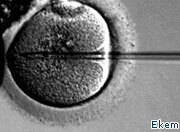Scientists want to push ahead with plans to create GM babies, despite evidence that mutated DNA could still be passed on.
A team at Newcastle University has been trialing a version of Pro-Nuclear Transfer (PNT), which transplants DNA from one embryo into another, creating a child with the involvement of four parents.
Their research involved the destruction of hundreds of human embryos and sidelined the concerns of a host of scientists and ethics experts.
Unsafe
A report of the trial in scientific journal Nature claimed that the technique was likely to lead to normal pregnancies.
Deputy Director of The Christian Institute Humphrey Dobson said scientists “can’t possibly know that it is safe” and warned “problems may only arise in the generations to come”.
Mr Dobson also highlighted that the report showed faulty mitochondrial DNA was still found to be passed on in some cases.
He added: “We should remember that what is being heralded here as ‘treatment’ is simply a ruthless way of screening out those deemed less worthy of life.”
Regulations
In February last year, the UK became the only country in the world to legalise three or four-parent baby techniques, sometimes known as ‘mitochondrial replacement’.
The House of Commons and the House of Lords both backed regulations allowing the techniques, despite warnings against editing the human germ-line.
Numerous experts say gene editing could have devastating consequences for future generations and open the door to eugenics.
Serious doubts
A few months after the vote, scientists in Oregon, USA developed a revolutionary adult stem cell treatment which could lead to a cure for mitochondrial diseases without resorting to the controversial GM baby techniques.
A study by Oregon Health & Science University in July 2015 suggested that people suffering from rare mitochondrial diseases could be helped by a technique which uses their own skin cells.
Commenting on the development, Professor Darren Griffin, Director of the Centre for Interdisciplinary Studies of Reproduction at the University of Kent, said: “The authors have devised a very elegant system to correct the genetic defect in question.”



